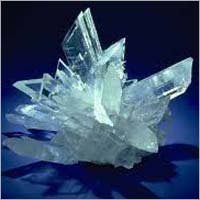Gypsum is a soft mineral composed of calcium sulfate dihydrate and is widely mined and used as a fertilizer, and as the main constituent in many forms of plaster, blackboard chalk and wallboard.
A variation of gypsum called alabaster which is fine-grained white or lightly tinted has been used for sculpture by many cultures including Ancient Egypt, Mesopotamia, Ancient Rome, Byzantine empire and the Nottingham alabasters of Medieval England.
The word gypsum is derived from the Greek word gypsos, “plaster”. Plaster of Paris is dehydrated gypsum and the name is derived from the fact that the quarries of the Montmartre district of Paris have long furnished burnt gypsum (calcined gypsum) used for various purposes.
Upon addition of water, the plaster of Paris becomes regular gypsum (dihydrate) again, causing the material to harden or “set” in ways that are useful for casting....

